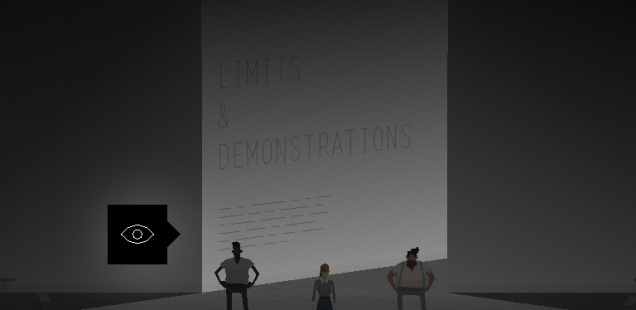
Opened World: Art Imitates Art
Miguel Penabella shares one of three opinions.
“Opened World” is a column born out of a question: how do videogames fit within a broader culture of art and criticism? As the medium matures, games demand more rigorous analysis as it intersects with film, literature, theatre, and art history. By considering videogames’ relation to other cultural contexts, we open the possibility for deeper meaning and inquiry.
Cardboard Computer’s Limits & Demonstrations (2013) is the kind of quiet, understated game that at first glance seems merely a fleeting companion piece to be experienced and later sidelined upon the arrival of the next act of the grander Kentucky Route Zero storyline. To say that Cardboard Computer upends such an assumption by crafting a game as evocative and fully developed as their full-length acts is another way of saying that interludes like Limits & Demonstrations—along with The Entertainment and Here and There Along the Echo—deserve substantial recognition on their own terms.
You guide a trio—Emily, Ben, and Bob—through a museum’s retrospective of the works of artist Lula Chamberlain as they view, appreciate, and discuss the exhibitions on display. A placard at the entrance of the retrospective describes the affair as “a diagonal slice through time, space, and form,” suggesting a kind of obliqueness in meaning and imagery. On the one hand, the installation artworks have an off-kilter, imagined quality to them, and on the other, Limits & Demonstrations is itself a diagonal tangent right off the main storyline of Kentucky Route Zero, like a brief detour along the road.
There’s a sense that what Cardboard Computer is after in their magical realist foray is a sideways glance at Americana, portraying dreamlike locales steeped in folklore and memory over real places. If Kentucky Route Zero is a road trip through a surreal American landscape, then stopovers like this interlude allow for strange encounters and diversions not seen along the highway. I’m reminded of John Steinbeck’s novel The Grapes of Wrath and its interlude chapters that offer discreet passages about characters and micro-narratives unconnected to the main storyline that nonetheless comprise a grander folklore. Limits & Demonstrations deepens our appreciation of Kentucky Route Zero while providing its own self-contained narrative, similarly conveying an interest in the obscure back roads of the midcentury and delving into iconography culled from photography and architecture that have turned mythic over time.
Emily, Ben, and Bob are the characters through which we experience the Lula Chamberlain retrospective, and their musings on the artworks inform how we come to interpret its sounds and imagery. The trio should be familiar to those who’ve played Kentucky Route Zero, having appeared as the game-playing basement people in Act I as well as the museum guests in Act III. Their uncanny, recurring presence throughout these games evokes a Greek chorus, commenting on the events from a distance. Further cementing this choral function, they also serve as members of the bluegrass band The Bedquilt Ramblers (in Act I’s basement scene, their instruments are present and disappear with them), who intermittently appear in the diegesis to perform songs. Adding to this complexity is the notion that Emily, Ben, and Bob double as loose fictionalizations of Emily Cross, Ben Babbitt, and Bob Buckstaff, who worked on the game’s soundtrack.
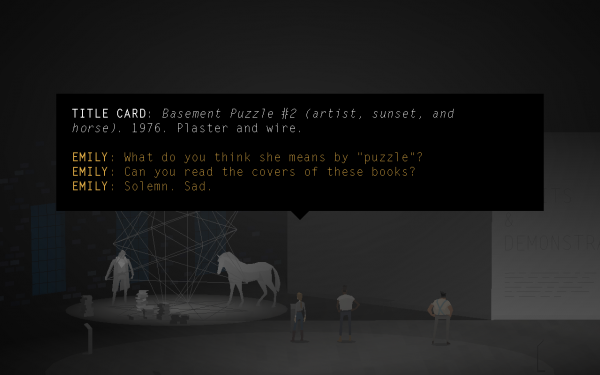
In Limits & Demonstrations, we’re offered direct oversight of these characters and allowed entrance into their mindsets. The gameplay largely consists of strolling through the oracular exhibition space and navigating dialogue menus much in the same way as Kentucky Route Zero. As in that game, there’s a sense of open-endedness to the gameplay. A series of dialogue options to interpret and engage with the artwork appears, allowing the player to choose what pertinent questions to ask aloud or to determine a particular means of reception— if the characters feel moved by it, or if they think it’s attractive.
By extension, Limits & Demonstrations asks you to arrive at your own ideas or feelings towards each artwork displayed. Once all the dialogue for a particular exhibit is exhausted, you cannot revisit the artwork for new thoughts, and the only action is silent contemplation. There’s a sense of finality in what judgment is made, and any lingering understandings among the characters remain unspoken.
These dialogue options don’t factor into whether you get a “good” or “bad” ending as branching conversations in most games tend to do, but function more as a means to develop mood and characters through subtle affectations. You roleplay as Emily, Ben, and Bob, judging what kind of character development these figures will have based on your dialogue choices. Such decisions do not feed back into a grander causal system other than the continuation of dialogue, but they are meaningful because you craft the emotions, worldview, and temperament of the characters, thus shaping the narrative. Lindsey Joyce goes further into these ideas with greater depth in her essential piece on Kentucky Route Zero, and Limits & Demonstrations broadens the scope of this gameplay in the context of receiving art. The characters’ engagement with art reflects our own; their inquiries guide our thinking as we guide them.
The exhibit’s description notes that Lula Chamberlain’s works pushed both viewers and exhibitors alike because venues struggled to install her art and keep it operational for long, imparting an unreal, ephemeral quality to the oeuvre. The displays are illuminated upon stepping close to it, evoking a theatrical presentation like the start of a scene in a play. It’s a mostly colorless affair—the gallery space is awash in gray drywall, black shadows, and pale white light—and Limits & Demonstrations has a ghostly intimacy in this aesthetic.
The installations are spooky in turn. Vertex Texture Fetch depicts a domestic milieu made faintly surreal and eerie: A suspended cathode ray tube swings continually over a television with an unrecognizable image as though propelled by an otherworldly energy. Its hypnotic pendulum and the periodic whining noise it emits recalls Steve Reich’s installation piece Pendulum Music, both works sharing a Fluxus attentiveness to mixed media and a sense of game-like interactivity.
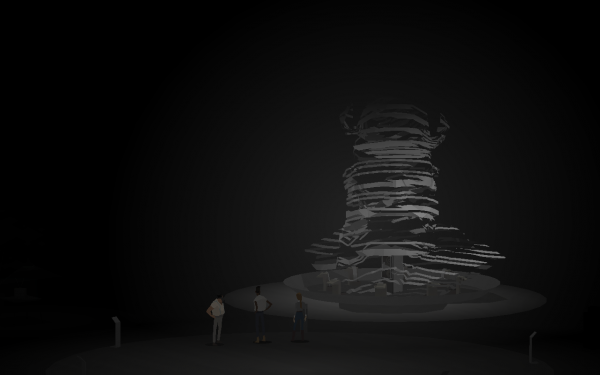
The work Visage also has vaguely supernatural characteristics. Unknown media resembling ribbons of paper flutter impossibly in place, towering over viewers and contorting into a human face as though the whirlwind were alive. Like the mysterious swinging light of Vertex Texture Fetch, Visage seems to flicker towards consciousness before vanishing completely. The same can be said for Spinning Coin, Suspended, Correcting for Angular Motion, which looks like a giant computer monitor balancing on one point and wobbling slightly. It’s as though technology has been rendered animal-like, possessing a mind of its own as it corrects its balance. The display is mundane yet dreamlike.
Emily, Ben, and Bob comment aloud with each passing work, taking turns asking questions and answering, and their dialogue becomes a kind of game in itself. Upon examination of Basement Puzzle #2, the characters note the inherent game-ness of the work. It’s called a puzzle, connoting the need to be solved by the one appreciating it; the work suggests that simply engaging with art is interactive and worthy of our efforts. This notion is beautifully crystallized in the interactive centerpiece of the gallery, Overdubbed Nam June Paik Installation, in the style of Edward Packer.
Presented as a series of magnetic audio tapes recorded periodically from 1965 to 1980, the installation is splayed out on a wall for onlookers to move the tape playback head on various points according to the instructions provided. Emily, Ben, and Bob handle the physical movement of the recordings while you navigate their dialogue. The shared authorship of the installation—Lula Chamberlain, Nam June Paik, Edward Packer, and Cardboard Computer—further recalls the values of midcentury Fluxus art and its emphasis on collective creation and authorial multiplicity. It’s worth parsing out each author and their contributions to Limits & Demonstrations because the game is deeply intertwined in a complex network of allusions, fictionalizations, and historical ambiguities that enrich our experience.
Edward Packer undoubtedly refers to Edward Packard, the author known for conceptualizing the Choose Your Own Adventure series of books that predate videogame text adventures. The installation works similarly, but instead of turning to a page, the characters move to another point on the tape recording to advance the storyline. Thus, Limits & Demonstrations fuses text adventure with audio elements. We read the words since there’s no voice acting in the game, but we hear background noises like a moving car or interior ambiance. Because the work was recorded over a period of fifteen years, there are ellipses where we must fill in the nuances of Lula’s personal life and her relationship with the two men Joseph and Donald.
Adding another layer of text is the work of Nam June Paik, whose audiotape installation Random Access is the primary inspiration for this exhibition, its recordings similarly posted on a blank wall. It makes sense that Cardboard Computer would be interested in the work of the artist because both Kentucky Route Zero and Nam June Paik integrate television screens as important motifs. His famed installation Electronic Superhighway: Continental U.S., Alaska, Hawaii involves television screens framed by neon tubes in the shape of the United States map. Paik envisions an interconnected network of digital routes and passages that traverse the country; Kentucky Route Zero envisions a network not of digital media but of myth and memory.
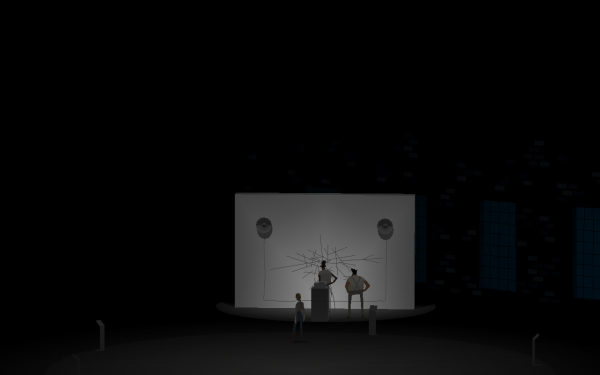
In this world, roadways are less physical than they are mental. The magnetic tapes of Overdubbed Nam June Paik Installation resemble the tangled highway map of Kentucky Route Zero or the labyrinthine cave systems mentioned by Lula in her recordings, tying the artwork to an imagined world. Drawing from a tradition of distinctly American travel narratives like William Faulkner’s As I Lay Dying or the aforesaid The Grapes of Wrath, Cardboard Computer loosely sketches a portrait of Americana informed by the mythic, folkloric stories passed down and remembered.
Like Kentucky Route Zero and the magical realist literature it draws from, Limits & Demonstrations is interested in this strange blend of reality and fiction. Lula Chamberlain may or may not be a real artist; what matters is that she’s somewhere in between. There are real-world galleries exhibiting her “works” in similar retrospectives even as the game fictionalizes her backstory. Obscured through history and hazy memory, very little trace of her work or secondhand writing survives, and Chamberlain remains so obscure that it’s unclear what’s real about her life and what’s merely speculated or even manufactured altogether.
If we are to take Lula Chamberlain as a real artist, then we understand her as belonging to the midcentury avant-garde alongside figures like Nam June Paik, John Cage, or Allan Kaprow, but forgoing the scene in New York City to live in solitude in Mexico. Even though little information is known about her, partly “because she’s female, and because she was working in an area that doesn’t receive a lot of recognition,” art curator Lee Tusman presented a gorgeous Lula Chamberlain retrospective that sought to recreate her installations and inform audiences of her life and work. Likewise, an amazing booklet by Nicolas Maravitti bridges Chamberlain with cultural and historical reference points but still muses on the mythic nature of her existence.
Much of Limits & Demonstrations folds together reality and fiction, suggesting that Chamberlain disappeared below the surface of the Zero and was involved in a decades-spanning love triangle with characters Joseph and Donald. The tape recordings detail their arcing relationships, clearly a crucial divergence in their lives. This conflict resurfaces in the first act of Kentucky Route Zero where Joseph appears as an actual character. You find his videogame If I Had My Way, I’d Tear the Building Down within the archives of a museum, and its description as involving a “tangled, painfully concave love polygon” mirrors the one in the tape recordings of Limits & Demonstrations. Indeed, trios of characters recur across these games: Emily, Ben, and Bob double as Lula, Joseph, and Donald, and multiply again in protagonists Shannon, Conway, and the dog in Kentucky Route Zero.
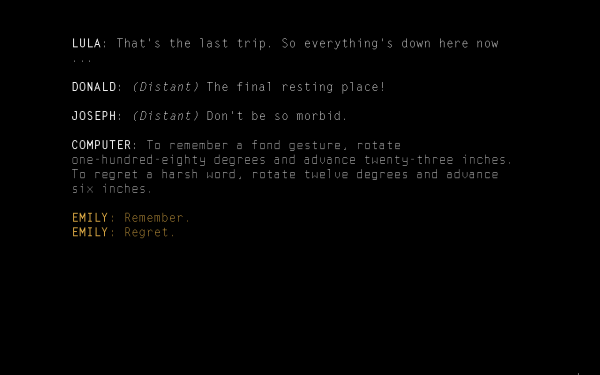
Limits & Demonstrations may only take ten minutes to complete, but it demands greater attention to a network of artistic ideas, histories, myths, and allusions. It is not a game of easy answers but information deployed diagonally; not puzzles in the traditional sense, but language and themes itself as puzzling. Cardboard Computer has the conviction to let meaning remain mysterious, floating somewhere in the midcentury psyche and restlessly waiting to be stirred from within. Indeed, Limits & Demonstrations conjures the kind of surreal, unidentifiable state of mind somewhere between dreaming and wakefulness. You close your eyes to sleep, and the differences between what’s real and what’s imagined no longer matter.
Miguel Penabella is a freelancer and comparative literature academic who worships at the temple of cinema but occasionally bears libations to videogames. His written offerings can be found on PopMatters, First Person Scholar, and Unwinnable, and he blogs on Invalid Memory.